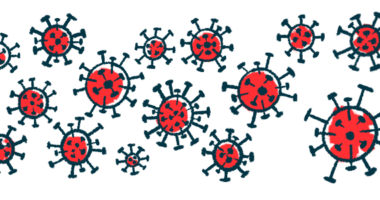Low NMOSD risk after COVID-19 infection or vaccination: Review
Global data do not suggest infection or vaccination caused NMOSD cases

The rate of disease onset or relapse of neuromyelitis optica spectrum disorder (NMOSD) after a SARS-CoV-2 infection — the virus that causes COVID-19 — is extremely low, at about 1 in 50 million, according to a worldwide review study.
The occurrence of NMOSD was even lower, at 1 in 500 million, after vaccination, data show. In addition, nearly all patients who developed NMOSD or relapsed after infection or vaccination completely or partially recovered with standard treatment.
While the review suggests a potential and extremely rare link between COVID-19 infection or vaccination and NMOSD, it does not “imply causation,” researchers wrote, meaning the data do not demonstrate that infection or vaccination caused the NMOSD cases reported.
“The protective benefits that the COVID-19 vaccine conveys to both the individual and society as a whole far outweigh any hypothetical risk that would be implied from this review,” researchers noted.
The study, “New onset or relapsing neuromyelitis optica temporally associated with SARS-CoV-2 infection and COVID-19 vaccination: a systematic review,” was published in the journal Frontiers in Neurology.
SARS-CoV-2 virus can also dysregulate immune system
Beyond respiratory involvement, the SARS-CoV-2 virus can also dysregulate the immune system and access the brain. Accordingly, case reports have suggested that SARS-CoV-2 may trigger neuroinflammatory autoimmune disorders such as NMOSD, in which the immune system produces self-reactive antibodies that mistakenly attack the brain and spinal cord.
“The underlying [disease-associated] mechanism that leads to NMOSD is unclear, but mounting evidence suggests that there is an intricate interplay between environmental factors, such as vaccines and viral infection, and genetic susceptibility that leads to [brain and spinal cord] inflammation,” the researchers wrote.
Because COVID-19 infections are likely to continue, “it is essential that we elucidate the association between [these] SARS-CoV-2 infections and neuroinflammatory conditions such as NMOSD,” the researchers added.
To investigate the incidence of NMOSD following SARS-CoV-2 infection, as well as after COVID-19 vaccination — given that vaccines are designed to mimic infection — a team of researchers at the University of Maryland systematically reviewed studies published up to Sept. 13, 2022, describing such cases.
Of a total of 348 studies assessed for eligibility, 34 — covering 41 cases — were included in the analysis.
A total of 15 patients (73% females), ages 7.5-71 years, in 12 countries developed NMOSD during or after SARS-CoV-2 infection. Based on 626,337,158 COVID-19 cases worldwide as of the end of October 2022, the incidence of NMOSD following a SARS-CoV-2 infection was 0.02 per million (1 in 50 million).
Transverse myelitis, or spinal cord inflammation, was the most common NMOSD manifestation, occurring in 10 patients (67%). This was followed by seven cases (47%) of optic neuritis, or inflammation of the optic nerve that sends signals between the eye and brain.
Two patients (13%) had previously been diagnosed with an immune-mediated condition.
The protective benefits that the COVID-19 vaccine conveys to both the individual and society as a whole far outweigh any hypothetical risk that would be implied from this review.
Most infected patients fully or partially recovered after treatment
Of the 13 cases with information on treatment, 12 (92%) initially received into-the-vein methylprednisolone, an anti-inflammatory and immunosuppressive medication commonly used in NMOSD.
Five (39%) also received the blood-cleaning procedure plasmapheresis, and 3 (23%) received intravenous immunoglobulin, which provides purified antibodies from healthy people to counteract NMOSD-driving self-reactive antibodies. Maintenance immunosuppressive therapy, including rituximab and azathioprine, was given to four patients.
Most patients (84%) fully or partially recovered after treatment, while two patients died of complications related to SARS-CoV-2 infection and specific treatment.
A total of 26 patients (76.9% female), ages 19-80, in 13 countries developed new NMOSD-related nerve damage after COVID-19 vaccination. Most (81%) experienced their first NMOSD attack, while five (19%) had a disease relapse.
Overall, more than half of the cases (54%) occurred after an mRNA vaccine such as the Pfizer-BioNTech vaccine. Nearly a third (31%) occurred after a vaccine using a modified viral carrier such as that used in the Oxford-AstraZeneca vaccine.
Based on 12,830,378,906 vaccine doses given as of the end of October 2022, the incidence of an NMOSD attack following vaccination was 0.002 per million (1 in 500 million).
This is in agreement with a previous review study reporting that the occurrence of NMOSD attacks following COVID-19 vaccination is rare and not associated with a particular type of vaccine.
31% who developed NMOSD post-vaccination had prior immune condition
Notably, eight of the 26 patients (31%) who developed NMOSD post-vaccination had a previously diagnosed immune-related condition, while four (15%) had a family history of such conditions, including NMOSD. Like with infections, transverse myelitis was the most common symptom (65% of patients), followed by optic neuritis (19%).
All but one patient (96%) was started on into-the-vein methylprednisolone, with 12 (46%) also receiving plasmapheresis and one (4%) intravenous immunoglobulin. Nearly half of the patients (46%) received maintenance immunotherapy, most commonly rituximab and azathioprine.
Overall, 22 of 25 patients (88%) achieved a complete or partial recovery following treatment, with two patients (8%) not improving and one patient dying of an unreported cause.
Patients who developed NMOSD after a COVID-19 vaccination were, on average, more than 10 years older and were more likely to have co-existing autoimmune conditions than those who developed NMOSD after a SARS-CoV-2 infection (31% vs. 13%). They were also more likely to test positive for anti-AQP4 antibodies, the most common type of NMOSD-driving self-reactive antibodies (85% vs. 65%).
While the two groups had similar rates of transverse myelitis, the infected group was more likely to have optic neuritis (47% vs. 19%) and brain stem involvement (33% vs. 12%).
Mortality rates were similar between groups.
“This systematic review does suggest that [NMOSD] manifestations following a COVID-19 viral or vaccine exposure may be more common than currently recognized, particularly among high-risk demographic groups,” the researchers wrote.
“This association requires further study using quantitative epidemiological assessments in representative populations to better quantify the risk of developing clinical symptoms of NMOSD,” they added.








